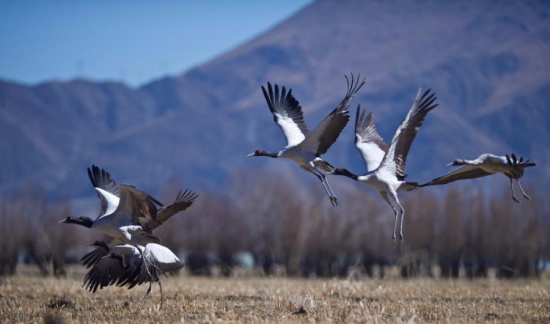
Black-necked cranes seen near Nyangqu River in Xigaze, Southwest China's Tibet autonomous region on Jan. 19, 2018. Due to their scarcity, black-necked cranes are now under first-grade state protection. Tibet has become the world's largest winter habitat for this bird species and now visitors can spot these elegant creatures bathing in warm sunlight near the Nyangqu river valley. (Photo/Xinhua)
China's cabinet has approved plans by 15 provincial-level regions to draw ecological "red lines" to strengthen environmental protection, the Ministry of Environmental Protection (MEP) said Monday.
The State Council has authorized the red line plans from Beijing, Tianjin, Hebei, Ningxia, and 11 regions along the Yangtze River Economic Belt, according to Cheng Lifeng, head of the MEP's Department of Nature and Ecology Conservation.
The zones demarcated by the red lines have a combined area of 610,000 square km, or about a quarter of the total land area in the 15 provincial regions, said Cheng.
They cover various nature reserves, scenic areas, forest parks, geological parks, and wetlands, he said.
Last year, central authorities issued guidelines on the ecological red line strategy that will enforce strict protection over certain zones. The zones will be clearly defined nationwide by the end of 2020, according to the guidelines.
Cheng said the country's 16 remaining provincial-level regions should complete the drawing of their ecological red lines by the end of 2018.
Human activity will not be banned in the red line zones, but will be under rigorous regulation, said Gao Jixi, an environmental expert advising the MEP.
The zones can be rationally developed, but their area should not be reduced and their ecological functions should not be harmed, Gao said.
China is in the midst of a campaign to fight pollution and contain environmental damage, as decades of growth have left the country with smog, polluted water, and contaminated soil.
The Communist Party of China has incorporated "Beautiful China" into its two-stage development plan for the building of a great modern socialist country.
The government has passed its toughest-ever environmental protection law, and introduced a "river chief" system to protect water resources.


















































